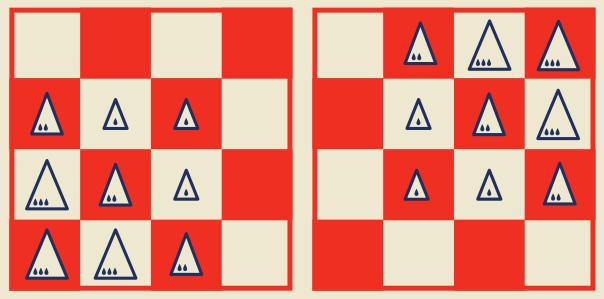Martian Chess
Official Rules from LooneyLabs.com
These are the official rules for Martian Chess, word for word, as provided by the Looney Labs website --
Overview
In Martian Chess, color means nothing. Instead, location determines which pieces you may move. As in Chess, each type of piece has its own way of moving, and you capture by entering an opponent piece’s square. However, you can move only the pieces sitting in your section of the board, and you can only attack pieces in another player’s zone.Thus, a piece changes ownership after it attacks. The game ends when a player has no pieces left in their zone.
GoalScore the most points. (“Checkmate” is an Earthly concept; the term has no meaning here.)
Terminology
Pawn: Small pyramid.
Drone: Medium pyramid.
Queen: Large pyramid.
Canal: The dividing line separating the players’ zones.
Zone: One player’s half of the board.
Each player starts by setting up their nine pyramids in opposing corners of the board, creating a 3x3 square in the right-hand corners of each end (not as exact mirrors, but rotationally symmetrical). Start with a Queen in the corner and two more Queens on either orthogonal side. Next, add a diagonal row of Drones that share sides with the Queens. Finally, fill in the square with Pawns in a similar-but-opposite setup as the Queens.

Courtesy of LooneyLabs.com
How to Play
On your turn, move one of the pieces in your zone in a straight line, passing through unobstructed spaces according to its movement ability. Jumping is not allowed.
- Pawn: One space at a time, in any of the diagonal directions.
- Drone: One or two spaces, on either the horizontal or vertical lines.
- Queen: Any distance, in any straight-line direction: horizontally, vertically, or diagonally.
You control ALL and ONLY the pieces currently in your sixteen-space zone of the board. After you move your piece into another player’s area, it stops being your piece.
CapturingWhen your piece moves into a space occupied by an opponent’s piece, remove their piece from the board and keep it for scoring. Any piece can capture any piece. Capturing a piece always involves moving a piece across the Canal and losing control of it upon completion of the capture.
No UndosYour opponent may not “reject” your move; if one player moves a piece across the canal, the other can’t move it back to the same square it came from.
Field PromotionsIf you have no Queens, you can create one by moving a Drone into a Pawn’s space (or vice versa) and merging them. Similarly, if you control no Drones, you can make one by merging two of your Pawns. (The pieces being merged should be removed from the board immediately and replaced with a single piece of the combined size.)
Ending the GameThe game ends as soon as one player’s zone is totally empty. This means if you have only one piece left, you can force the end of the game by moving your last piece across a canal.
How to WinEach piece you capture is worth its pip count in points. The winner is whomever has the highest score. (Pawn = 1 point, Drone = 2 points, Queen = 3 points.) If the game ends in a tie, the player who ended the game is the winner.
---- Other Notes ---- Four-Player Martian Chess
If you have a regular chessboard, you can play Martian Chess with four players. Just set each player’s set of nine pyramids in a corner of the board, and envision canals dividing the board into fourths. Also, ignore the No-Undos rule when playing with more than two. (It’s not needed because of the increased volatility and diplomatic possibilities you get with more than two players.)
Eeyore's WedgesThree-player Martian Chess is possible, but use of a standard chessboard is not ideal, since the empty quadrant will unbalance the game. Fortunately, Elliott “Eeyore” Evans has designed wedge-shaped gameboards which allow for play by three, five, or six players. Of similar interest are the diamond-shaped multiplayer gameboard panels created by Bruno Curfs. Look for them online.
Randomizing ColorsSince color has no meaning in this game, the pieces should be mixed up to make it easier to ignore color. Here are two good ways to go:
- Rainbow-Style: Each player gets pieces that are of nine different colors.
- Shady-style: Players agree on two colors that look similar, such as yellow & clear, red & orange, or the two shades of blue. These 18 pieces are scrambled and distributed between the players.
- Beware the Double Whammy: Whenever you capture a piece, make sure the piece you moved isn’t in a position where it can immediately capture one of your own remaining pieces (unless you’re happy enough making an exchange...).
- Eyes on the Prize: Keep in mind that the goal is points, not position. This is particularly vital in a four-player game, when two people can use the Double Whammy on each other to quickly trade pieces for points.
- Run for the Border: If you’re ahead on points and low on pieces, try to end the game quickly by pushing your last few pieces across a canal.
Martian Chess is the second game ever invented for the pyramids. For details about its origins, please see the history section at the end of this book.
Credit: These are the official rules for Martian Chess, word-for-word, from the LooneyLabs.com website. Please support the inventors of this fascinating game by buying it from their website!